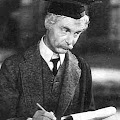
Arthur Rackham was born September 19, 1867, in London, England. He studied at the Lambeth School of Art, was elected to membership in The Royal Watercolour Society and the Société Nationale des Beaux Arts, and became Master of the Art Workers' Guild. Books he illustrated included Rip van Winkle (1905), The Ingoldsby Legends (1906), Alice in Wonderland (1907), and many other children's books and classics throughout the years until his death in 1939. His last work, for The Wind in the Willows, was published posthumously.
Rackham has been called "the leading decorative illustrator of the Edwardian period.... We see him.... in 1905 at the outset of twenty years of the most prolific and prosperous creative work ever enjoyed by an English illustrator." (Arthur Rackham, His Life and Work, by Derek Hudson, Charles Scribner's Sons, New York, 1960)
"Rackham's illustrations to Grimm, Hans Andersen or Poe show him at his most imaginative and observant of human nature, while his gnomes, fairies and gnarled anthropomorphic trees in Peter Pan in Kensington Gardens or A Midsummer Night's Dream represent his more fantastic side.... He was - and remains - a soloist in front of an orchestra, a player with the responsibility to interpret and add a personal lustre to great works with variations of infinite subtlety and grace." (Arthur Rackham: A Life with Illustration, by James Hamilton, Pavilion Books, Ltd., London, 1990; published in New York by Arcade Publishing, Inc. as Arthur Rackham, A Biography)
From The Arthur Rackham Society
"Rackham approached each picture in a similar manner, carefully drawing his subject in pencil until he was satisfied with the result and then inking over the pencil lines in India ink. For his color pictures he used transparent watercolors and laid down wash upon delicate wash. This technique gave his pictures an ethereal, other worldly quality and was especially suited to subjects of fantasy that he so loved..."
From http://www.nocloo.com/home/Biography/arthur-rackham-biography.html






















Oh my gosh, I love this! I especially love the 4th and 7th ones down. Can you still find books with his illustrations in? I already have a copy of the brothers grimm fairytales but to get one that's that nicely illustrated would be amazing, or Hans Christian Anderson's stories for that matter!
ReplyDelete